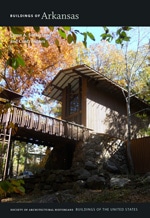Beginning in the late nineteenth century an abundance of decorative mass-produced millwork became available through catalogs or from local lumber dealers, making the picturesque architectural mode readily available even to those of modest means. This charming, rambling, cross-gabled one-and-a-half-story frame cottage, unified somewhat by its large wraparound porch, is made stylish by the generous application of a variety of jigsawn and turned millwork. Intriguing lacy patterns decorate the cutaway projecting bay and cornice and the posts and balustrade of the porch. The interior displays a similar decorative ensemble in oak for the door and window trim, built-in cabinets, and fireplace overmantels. Most spectacular are the three stained glass upper sashes of the front parlor windows, each inscribed, “Home, Sweet, Home.” Ensuring that his daughter would live close by, Ella Bunckley’s father, Elijah D. Watson, gave her the land for the house as a wedding present. It was across the road from number 502, his grander but less picturesque house.
That house built in 1870 for Elijah Watson, who was in the hardware business, and his wife, Sarah, is a two-story five-bay I-house built of wood, with exterior end brick chimneys and a central-hall plan. It is fronted by a central two-story pedimented portico with upper balcony. The portico’s monumental fluted Doric columns (taken from a house being demolished) were added in 1960, replacing the original square ones and creating a more definitive Greek Revival flair. The yard features formal gardens and towering magnolia trees, and a wrought-iron fence encloses the expansive garden of the house. The Watsons prospered from their local hardware business, which was established in 1865.





















